Conspiracy Talk
In the United States, the last Monday in May (this year, May 26) is Memorial Day. The Wizards of the Coast offices are closed today to mark the holiday, so we gave our Monday columnists the day off as well. Here is a rerun of Mark's article from last week, looking at Conspiracy (which releases on June 6). You can view many of the cards from Mark’s article and more on The Conspiracy Card Image Gallery.
—Mike McArtor, copy editor for DailyMTG
Welcome to Conspiracy Week. This week, we'll be talking about the new supplemental product you all are soon going to get a chance to get your hands on. It's a very different set, so I wanted to take today to show off a preview card; introduce you to the design team; and talk a little bit about how supplemental products come into being, using Conspiracy as an example. For those of you who want the nitty-gritty of Conspiracy's design, the product's creator and lead designer, Shawn Main, will have a feature article all about it tomorrow.
Okay, I'm going to start today by showing you my preview. I want to get you into the right mood for this product, so nothing's going to do that better than just showing you a card.
Meet the Deal Broker.
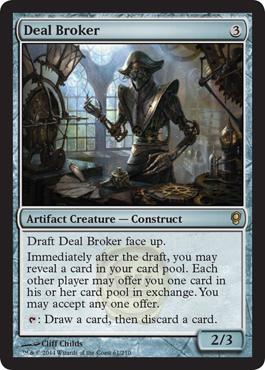
As this card demonstrates, Conspiracy is not your normal Magic expansion, but before I talk about how it came to be, let me first introduce you to the people who designed it.

Shawn Main
Normally, I always start my bios of Shawn talking about how he was the runner-up in the second Great Designer Search (which, technically, I've done again), but today, I want to focus a little more on the role Shawn has taken in Magic R&D. Shawn is a great designer and obviously excels on a design team. He also excels on development teams and digital teams and exploratory design teams and, well, just about any team he gets put on. Back when I was managing Shawn's time (Mark Gottlieb now has the honor of doing that as the design manager), I always had problems budgeting Shawn's time because everyone wanted him on their team, no matter what the team was.
Shawn is the Renaissance man of R&D. He's capable of handling anything you throw at him. So was I at all nervous when he was finally given his first design team lead? Absolutely not. Not only was this his baby (I'll talk about this in a second), but Shawn had proven he was ready and, as you will see, he was. Conspiracy was a difficult and unconventional design that Shawn managed to hit out of the park.

Dan Helland
There's a lot of busy work in R&D. For years, the designers and developers used to handle it all ourselves, but as we got more and more on our plates, it was clear we needed some help. Dan was originally brought in to do some temporary help and he became so invaluable that he was upgraded to fulltime. For example, I am currently in "devign" in a set ("Blood," for those who care), which means I have to update the file every week and run a playtest. All I have to do is drop Dan a note and right before the playtest, everything I need is ready for us. I can't put into words how invaluable Dan's help is. (Okay, yeah, I guess I just did.)
Dan loves multiplayer play, so when Shawn was putting together his design team, he asked if Dan was interested and Dan enthusiastically said he was. Dan is a man of great passion who loves Magic and multiplayer play and, as he has proven, is super-efficient, so he ended up being a great addition to the team.

Dave Humpherys
Dave is a former Pro Tour player with such an outstanding record that he got inducted in the Pro Tour Hall of Fame. Dave is the development manager (the equivalent role of what Mark Gottlieb does for the design team) and has led the development of numerous sets (Avacyn Restored, Gatecrash, and "Sweat"—the winter set of 2015), including Conspiracy. Every set needs a development representative, but one of the things Dave likes to do is be on the design team of sets he is going to lead development on.
Dave has a great insight into the game and always helps by asking pointed and key questions about the design as it evolves. I have been on numerous design teams with Dave and I always enjoy getting his take on how things are coming together. Conspiracy was a very challenging set to develop, so having Dave on the set the whole way through proved to be invaluable.
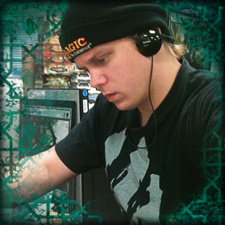
Ken Nagle
After all the bios I've written, what is there left to say about Ken Nagle? He's gone from being my young, inexperienced intern to being the married veteran of the design team. Ken loves designing Magic and he loves offbeat play formats and he loves multiplayer play, so Conspiracy was in his wheelhouse. The best thing I can say about Ken is that in all the years I've worked with him, he's never lost his enthusiasm for the job and he keeps designing wacky, wacky cards. Luckily, this was a wacky, wacky set.
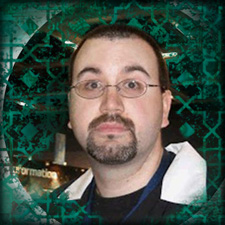
Matt Tabak
Shawn knew he was paving new ground, so who better to ask to be on the design team than the rules manager? Conspiracy was messing around in space that no other set had ever messed around in, so having someone who understood what wasn't yet understood was valuable. In addition, it turns out Matt Tabak is actually a pretty good designer. For some reason, rules managers seem to have a knack for designing cards that cause the rules managers headaches. I'm sure Matt Tabak, the rules manager, had a few cross words to say about Matt Tabak, the Conspiracy designer.
Whispers Behind the Scenes
The rest of today's column is going to be me answering questions about Conspiracy:
What exactly is Conspiracy?
Conspiracy is a multiplayer draft product. What does that mean? It means it's a booster product designed to be drafted and then played in multiplayer games. The suggested way to play is to have an eight-person draft and then break up into two four-person free-for-all games.
What's in it?
Conspiracy has 210 cards, 65 of which are new. The set has three new mechanics (dethrone, will of the council, and parley) and one new card type (conspiracy). It has five new legendary creatures and one new Planeswalker, Dack Fayden. The reprints were chosen to be cards popular for multiplayer, Cube, Legacy, and Vintage formats.
Three mechanics and a new card type? What are they?
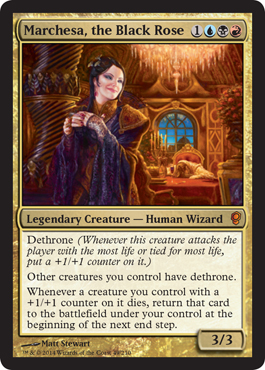
The first mechanic is called dethrone. Here is its reminder text: (Whenever this creature attacks the player with the most life or tied for most life, put a +1/+1 counter on it.) It's primary in red and secondary in blue. It's designed as a way to promote attacking in multiplayer play in a way that causes less enemy-making.
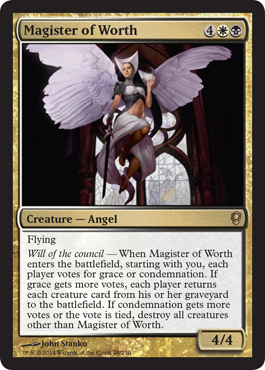
The second mechanic is called will of the council. When a card with this mechanic is used, all the players get a series of options and then get to vote, with each player getting one vote. (And yes, there's a way to get more votes.) Some of the votes are an A/B choice, but others give players a list of options. This ability is primary in white and secondary in blue.
This mechanic is my one contribution to the set. While reviewing the set with Shawn, I brought up a series of cards I had made for Unglued 2, the Un-set that never got made (you can read about it here), where players got to vote about the outcome of spells. Shawn liked the idea and felt it fit well with what the set was doing.
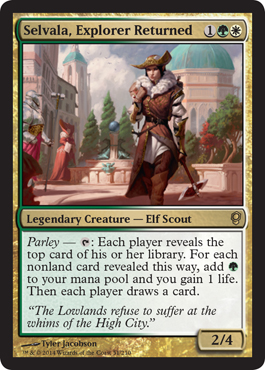
The third mechanic is called parley. It's an ability word with the following text: "Each player reveals the top card of his or her library. For each nonland card revealed this way... [something good happens]. Then each player draws a card."
This mechanic plays around with two areas that work well with this set. First, it creates an effect that scales based on how many people are playing, making it well-suited for multiplayer. Second, the effect does something positive for all the players (although obviously even better for you), making it something with a little more diplomacy built in. The mechanic was designed to help with card flow, which is very important for multiplayer play, and is in green and white.
But all of these mechanics are not the true main course. The truly innovative part of Conspiracy is the draft-matters cards. The draft-matters cards fall into two camps: artifact creatures and conspiracy cards. Both types of cards have an effect that either impacts the draft or is impacted by the draft. For example, Deal Broker, my preview card from above, allows you to trade one card at the end of the draft. As it's an artifact creature, it can also be used for its non-draft abilities in the game.
A conspiracy card is something that starts the game in your command zone. Some of them grant an ability at the start of the game. Others have a hidden agenda and are kept face down until you use them later in the game. There are thirteen conspiracy cards in the set. The draft-matters cards were designed not just for Limited Conspiracy play but also as something for players to add to their Cubes (or any other format that makes use of drafting).
Dack Fayden? How'd he get in this set?

For those who are unaware, Dack Fayden is the greatest thief in the Multiverse and the star of the Magic: The Gathering comic book by IDW. When the creative team was trying to figure out how to concept the new cards from Conspiracy, they came up with an interesting idea. What if the new cards were all set in the High City of Paliano on the plane of Fiora? This city is the current home of Dack Fayden in the comics. And if you're going to set Conspiracy in Fiora, well...
We've talked a lot about putting Planeswalkers in supplemental products, and this opportunity felt like a great chance to test the waters. So I'm eager to see how the audience reacts to Dack Fayden.
Anything else exciting among the new cards?
As I mentioned above, for the Commander players, we've included five new legendary creatures, all characters from the world. Three of them are two-colored, one is mono-colored, and one is three-colored.

Art by Michael Komarck
There are 210 cards and 65 are new. What about the remaining 145 cards?
The remaining cards are all reprints. The goals of these cards are twofold. First, the product has been designed as a unique new play experience—multiplayer draft. Some of the reprints were chosen to maximize this format. Second, the reprints are trying to give players access to a number of cards that didn't make sense in or didn't fit the confines of Modern Masters.
Some of the cards are cards from the past that are fun multiplayer cards. Some of the cards are popular inclusions in Cubes. Some of the cards are cards for Legacy or Vintage. Also, the reprints make use of some mechanics from the past, chosen to enhance the Limited play. The three returning mechanics are multikicker, landcycling, and morbid.
How did Conspiracy come to exist?
The most common way we find our developers is to look at the Pro Tour, which means that our developers more often than not come from a similar vantage point. The most common way we've found designers, on the other hand, has been the Great Designer Search. Because anyone qualified can enter, we tend to get designers who come from more varied backgrounds when it comes to Magic play. Shawn Main, for example, tended to play more multiplayer games.
When Shawn got to Wizards, he started trying to see if he could get some others to play Magic the way he enjoyed it most. As he played these games, they started giving Shawn an idea. Could he turn this multiplayer draft thing he enjoyed into some kind of a set? We make supplemental products that play Magic in different ways (Commander, Planechase, Archenemy, etc.). Why couldn't this be one of them?
One of the things I try to stress to my designers is that part of being a good designer is seeing possibilities everywhere. A thing isn't a thing until someone decides to make it. If you have ideas that go in a space we haven't gone before, explore it. If you think you ended up with something with promise, show it to us. This is basically what Shawn did. He fleshed out his idea. Made different version he playtested with others. Then, when he was ready, he showed it to upper management in R&D. And we liked it.
Why isn't Conspiracy all new cards?
It takes a lot of time and resources to make new cards. In addition, there is a large backlog of old cards that many players would like to have access to. Conspiracy has a mix to allow players access to new cards while also making use of Magic's extensive back catalog. All of this has been combined to create a brand-new play experience.
Conspiracy seems to be continuing a trend over the last five years of Wizards doing more multiplayer products. Why is that?
I feel a big part of Magic's success over the last five years has been a shift in how we've been making the game. I feel that, for many years, we made what we thought was a fun game and then tried to encourage as many people as possible to play it. The big shift of five years ago was R&D starting to ask not "What should people be playing?" but rather "What are people playing?"
R&D has spent a lot of time trying to get a better sense of what Magic means to the playerbase and then worked to create more products (and sets and mechanics and cards) that address those needs. The Commander product is a perfect example. We realized the format was popular, so we made a product that could introduce it to others who might enjoy it but were unaware of its existence. What we found was that the very things that made it popular in the first place rang true with the new players who interacted with it.
As I often talk about, Magic is not a single game but an umbrella of games sharing a rules system and components. Part of expanding the game is learning how all the different players play it and then using the tools at our disposal to share this information with other players.
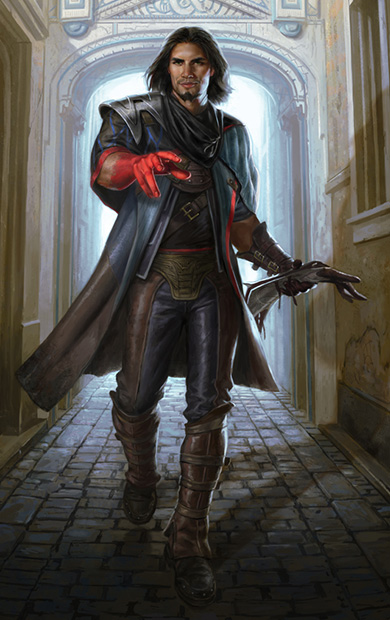
Dack Fayden | Art by Eric Deschamps
But Conspiracy didn't exist before? How is it sharing other aspects of the game?
Conspiracy is a good example of literal research and development. Shawn was well aware of different multiplayer styles of play. He also was clued in to the popularity of drafting. Conspiracy was Shawn taking different components and trying to fit them together in a new way. While the combination is new, the components have long been a part of Magic.
The thing I love most about Conspiracy is something that I love about design in general. A lot of innovation isn't discovering the wheel but reinventing it, of taking components that have proven themselves and then finding ways to mix and match them to create something new. I'll admit, I'm very excited for Conspiracy, because I love when we can show that Magic has the ability to keep evolving. Not many games make it to twenty years. The fact that Magic has done so while thriving and not resting on its laurels is mindboggling.
Is there anything else you want to say about Conspiracy?
Yes, there is one last thing. While I believe we have created something new, that doesn't mean I know exactly what all of you are going to do with it. The draft cards, for example, are us playing around in virgin space. Yes, people will use the draft cards in Conspiracy Limited, but what about other formats? Will they become popular in Cube? Will they inspire a new format that doesn't exist yet? I honestly don't know, and that is exciting.
Magic turns twenty-one this year, and the fact that we are still surprising ourselves is awesome. So please, make sure to check out Conspiracy, because it's something you truly haven't seen before.
Secrets In The Dark
I'm always interested in feedback but I am especially interested in what all of you think about Conspiracy. Have some opinions—positive, constructive—I want to hear it all. Email me through the link below, respond in the thread to this column, talk to me through my social media (Twitter, Tumblr, Google+, and Instagram). Tell me what you think.
Next week is Memorial Day, so Making Magic will be taking a week off, but join me the week after when I tell a bunch of truths along with a few lies.
Until then, may you try something you've never experienced before.
Drive to Work #122—Repetition
I spend a lot of time talking about all the new and different things we do in design, but today's podcast talks about the other end of the spectrum—doing things we've done before. Repetition is a big and important part of Magic design.
Drive to Work #123—Who's Who—R&D, Wave 1
If you want to know the history of Magic, you need to know the people who made it. Who's Who is going to be an ongoing mega-series where I talk about different people who were instrumental in the making of the game. Today, I start with what I call the first wave of R&D.
- Episode 123 : Who's Who—R&D, Wave 1 (19.6 MB)
- Episode 122 : Repetition (12.9 MB)
- Episode 121 : Zendikar, Part 4 (18.6 MB)
- Episode 120 : Zendikar, Part 3 (14.7 MB)
- Episode 119 : 1999 (13.6 MB)
- Complete Drive To Work Podcast Archive

